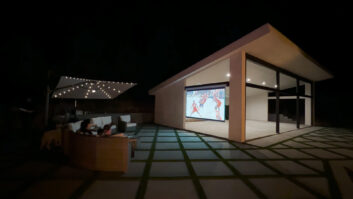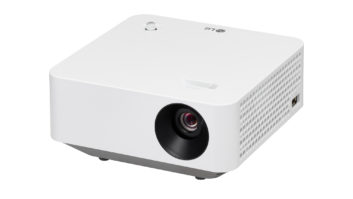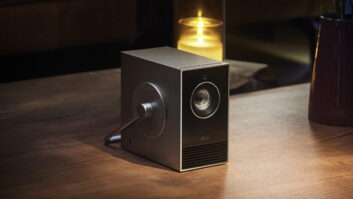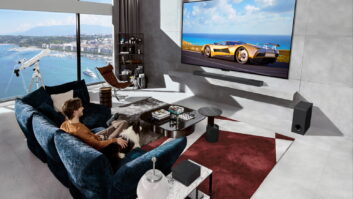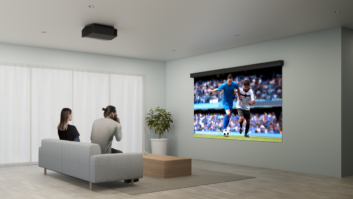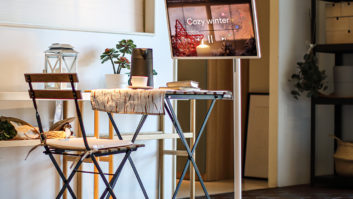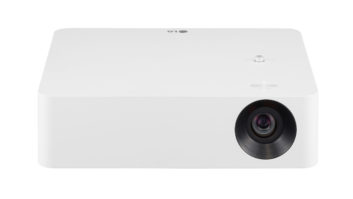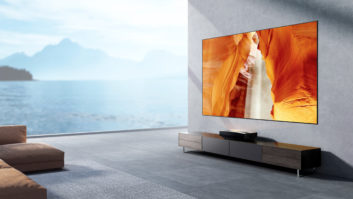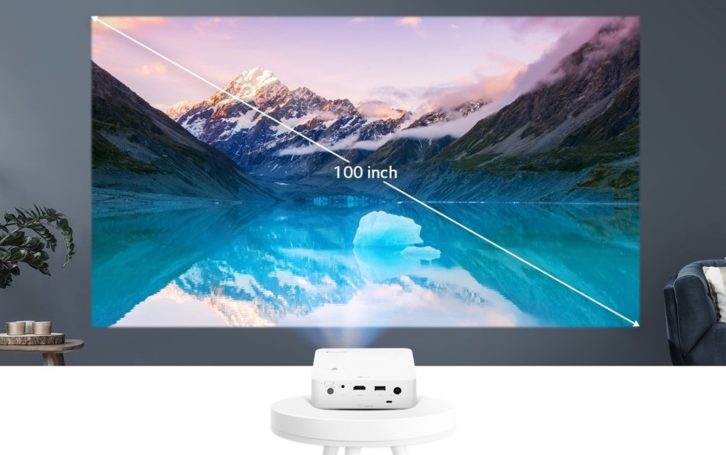
When I started getting serious about home theater back in the mid-’90s, I drove around the Bay Area in my quest to check out different front projectors from the likes of Sharp and Vidikron. From what I recall, most of the units in my budget offered either 640×480 or 800×600 resolution, which resembled watching a movie through a patio screen door, and sold for north of $5000. But damn if they weren’t impressive at the time!
Fast forward to today, and the advancements and improvements that have been made in front projection technology are nothing short of amazing, and LG’s new PH303N portable projector is a perfect example of exactly how far we’ve come. This new CineBeam model delivers HD (1280×720) resolution using long-lasting LEDs for the light source, can run on battery power, is small enough to toss in a backpack, and sells for under $400!
I’ll be honest, I’ve not had much experience with the portable projector category, but after reviewing the Elite Screens Yard Master outdoor screen, this seemed like a perfect companion. Outdoor entertaining is an increasingly growing category, but the video side of the equation can make for a tricky installation. Mounting a projector in a weather-proof enclosure isn’t right or practical for every job, and dragging a regular projector in and out of the house can be a hassle. With the PH3030N, you can easily tote the projector out for an evening, plop it onto a table or tripod, and bring it back in when done.
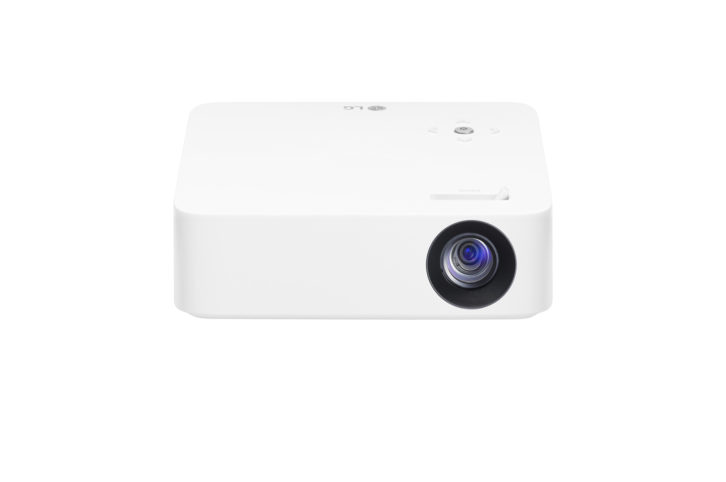
The PH303N was so new, my review unit shipped in from Korea. It’s incredible just how small and light this projector is; at roughly 5x5x1.5 inches and one pound, it is smaller and lighter than my first portable CD player. In the real world, you could easily toss this into a backpack or handbag for a camping trip and carry it around all day oblivious to its weight. When LG says “portable,” they aren’t kidding.
Connections include HDMI, USB, and a mini-jack output for analog audio. Image size is dictated by how far the projector is from the screen, with a simple top-mounted focus lever. At just over 4 feet from the screen it produces a 40-inch diagonal 16×9 image, and a 100-inch image at just under 11 feet. Ideally the projector sits flat and level, with the lens located at the bottom of the screen; a threaded insert on the bottom is available for mounting. If the projector can’t be properly positioned, vertical digital keystone adjustments are available.
The unit comes with a remote, but top-mounted controls are also available for making adjustments. A quick press on the power button brings up options for settings, input selection, and power, with directional arrows for adjustment.
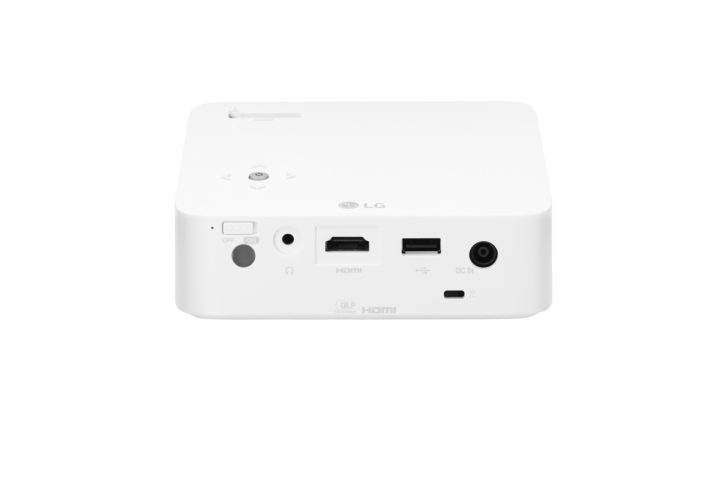
The projector supports the wireless AV protocol Miracast, but I had mixed results with it. For one, all of my phones/tablets are Apple and use Airplay, not Miracast. (Some third-party Miracast apps are available, but they are all pay versions, and the descriptions left me in doubt as to whether they would work.) Some Android devices support Miracast, but the two I had on hand didn’t. Windows 10 PCs do support Miracast, and while a desktop PC was very stable and had no issues, my laptop repeatedly lost connection, even when sitting right next to the projector. Also, when screensharing with Miracast, the projector drops into 4×3 mode, making a much smaller image, and locks you out of making any settings adjustments for some reason.
There is a built-in 1-watt mono speaker, but it is awful. At full volume, I could barely hit 60 dB at 1 meter, and from any seating distance greater than right next to the unit, it is barely audible. Fortunately, there is the mini-jack connection, which is great for headphones, and it has Bluetooth to send audio to a local speaker. I paired it with a Sonos Move to further simulate the wireless/portable experience and it was a great combo, though there is a slight lip sync delay when using Bluetooth, especially in combination with Miracast. (A lip sync adjustment is available when using the HDMI input.)
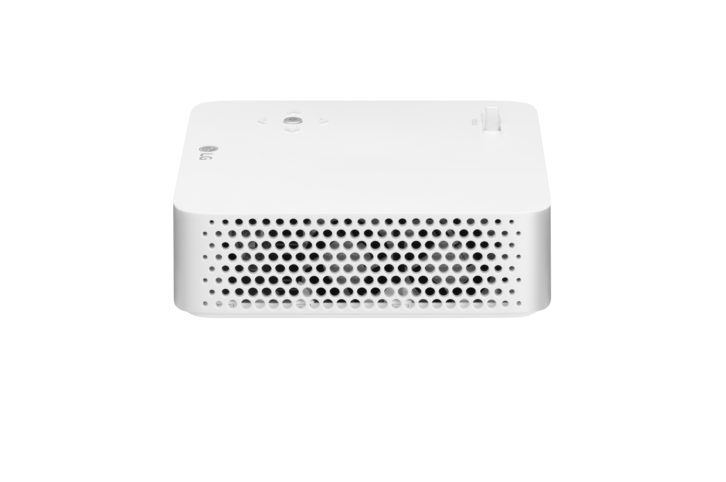
For something as truly portable as the PH30N, I would have expected LG to include some kind of carrying case or lens cover. I hate to think about this knocking about all day in my backpack unprotected, and even something like a neoprene sleeve would be welcome. LG noted that it has a “robust lens coating” protecting the lens and that a lens cover is not needed.
Thinking of the likely use cases for this projector, loading a bunch of content onto some thumb drives would be a great solution, especially for camping trips, and the projector supports a large array of file formats including .wmv, .avi, .mov, .mp4, .mkv, .vob, and more. I did most of my viewing using HDMI, and getting either an Apple or Android HDMI adapter would be another great portable solution. (Make sure to get a cable that supports HDCP so you can watch protected content from sources like Netflix or Hulu.)
As mentioned, the unit can run on its own internal, rechargeable battery, providing up to two hours of viewing on maximum battery (minimum brightness) mode; enough time to finish most movies. However, at this setting images are a bit dull, and things definitely look better when using maximum brightness, which reduces battery life to under 90 minutes. The PH30N delivers its best images and most pop (a rated 250 ANSI lumens) when running off AC power.
Related: Review – Elite Screens Yard Master Outdoor Projection Screen
While the projector’s resolution is 1280×720, it accepts signals up to 1080p via HDMI, and even turned the DTS-HD Master audio soundtrack from my Kaleidescape into something that could Bluetooth to my Sonos Move.
Watching Pixar’s Inside Out on my 92-inch Draper screen in a dark room looked pretty incredible, with bright, vibrant colors that had lots of depth and punch that totally captured the vivid reds of Anger, the glowing blues of Sadness, and the luminous yellows of Joy. Image quality went well beyond “watchable” and moved into “totally enjoyable,” where I stopped thinking about the projector and just enjoyed the movie.
Contrast is rated at 100,000:1, and even though blacks are really more a dark gray, the opening scrawl of Star Wars: The Force Awakens still had satisfying blacks, as did the opening battle scenes, with explosions having enough light to make you squint in a dark room.
Hamilton dropped on Disney+ while I had the projector, so we took it outside on July 4th and watched on the Yard Master screen. With the Yard Master’s diffusive quality and large image size, I felt like I was always reaching for the projector’s focus dial to try and tighten up the image, especially the subtitles (which I find helpful for picking up Lin-Manuel Miranda’s rapid-fire lyrics). Even at the best of times, the PH30N’s lens can’t resolve pixel-level sharpness, but again, watching Hamilton outside via a projector that almost fits into my pocket is pretty incredible.
Even though it can produce surprisingly enjoyable images on a good screen in a dark room, critical viewing isn’t what LG’s PH30N is about. Blasting a 100-inch movie onto the side of a sheet, house, or tent while your family is hanging outside or on a trip is where this excels, and at under $400, even if you only enjoy it a couple of times a year, it is an entertainment bargain.
800-243-0000; https://www.LG.com
Kudos: Incredibly portable; simple setup and operation
Concerns: Miracast wireless streaming, internal speaker, battery life
Product Specs:
- 1280×720 resolution DLP projector
- Fixed lens supports screens 25-100-inches diagonal (40-inches at 4.3 feet; 100-inches at 10.8 feet)
- Up to 250 ANSI Lumens; 100,000:1 contrast
- LED RGB lamp, up to 30,000-hour lifespan
- Embedded battery lasts up to 2 hours
- HDMI and USB inputs; 3.5mm audio output
- Bluetooth sound out
- Dimensions: 1 x 1.5 x 5.1-inches (WxHxD); 1.1 pounds
